1990 MITSUBISHI SPYDER coolant temperature
[x] Cancel search: coolant temperaturePage 528 of 2103
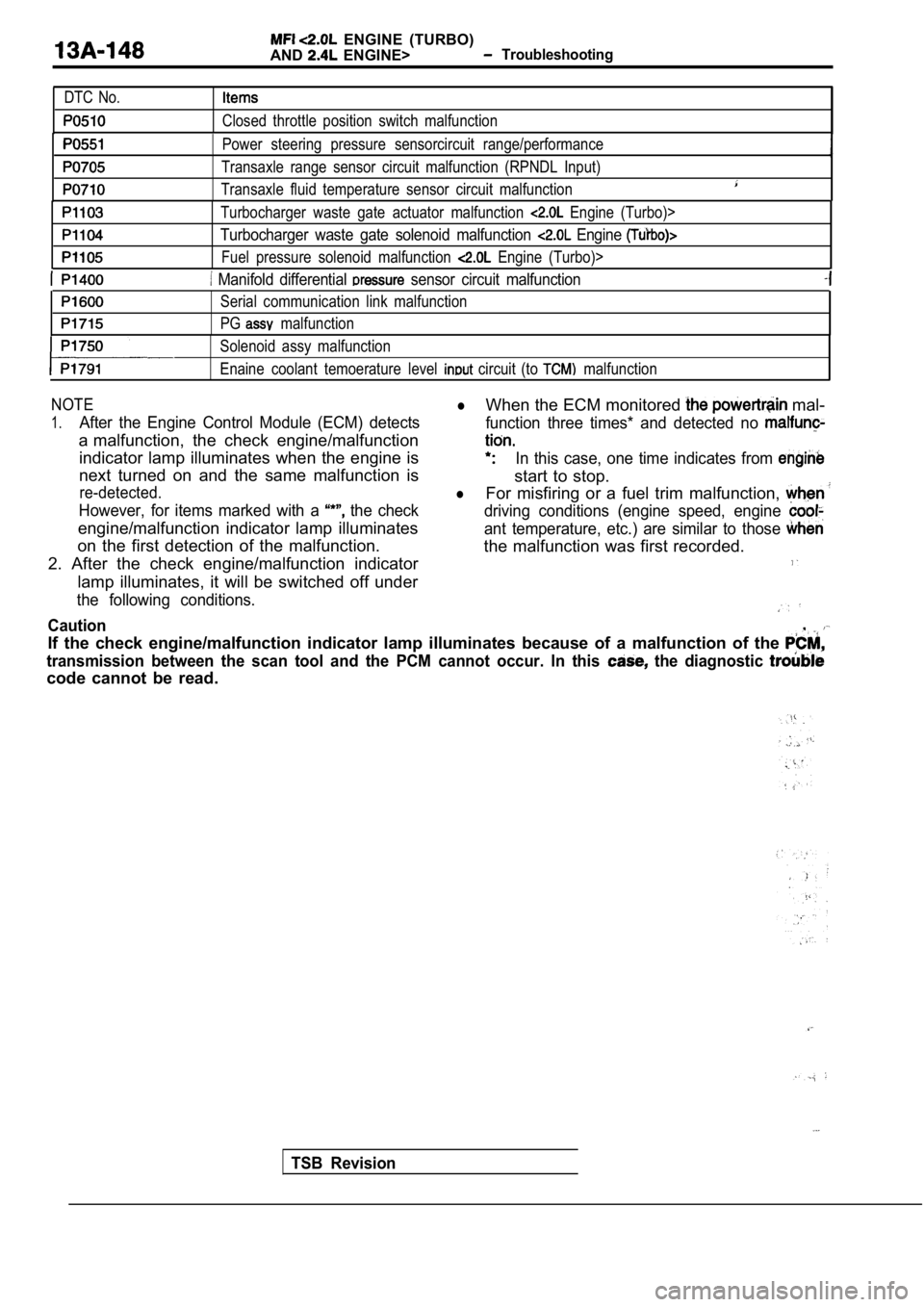
ENGINE (TURBO)
AND
ENGINE> Troubleshooting
DTC No.
Closed throttle position switch malfunction
Power steering pressure sensorcircuit range/perfor mance
Transaxle range sensor circuit malfunction (RPNDL Input)
Transaxle fluid temperature sensor circuit malfunct ion
Turbocharger waste gate actuator malfunction Engine (Turbo)>
Turbocharger waste gate solenoid malfunction Engine
Fuel pressure solenoid malfunction Engine (Turbo)>
Manifold differential sensor circuit malfunction
Serial communication link malfunction
PG
malfunction
Solenoid assy malfunction
Enaine coolant temoerature level
circuit (to malfunction
NOTElWhen the ECM monitored mal-
1.After the Engine Control Module (ECM) detects function three times* and detected no
a malfunction, the check engine/malfunction
indicator lamp illuminates when the engine isIn this case, one time indicates from
next turned on and the same malfunction is
start to stop.
re-detected.lFor misfiring or a fuel trim malfunction,
However, for items marked with a the checkdriving conditions (engine speed, engine
engine/malfunction indicator lamp illuminatesant temperature, etc.) are similar to those
on the first detection of the malfunction. the malfunction was first recorded.
2. After the check engine/malfunction indicator
lamp illuminates, it will be switched off under
the following conditions.
Caution,
If the check engine/malfunction indicator lamp illu minates because of a malfunction of the
transmission between the scan tool and the PCM cann ot occur. In this the diagnostic
code cannot be read.
TSB Revision
Page 529 of 2103
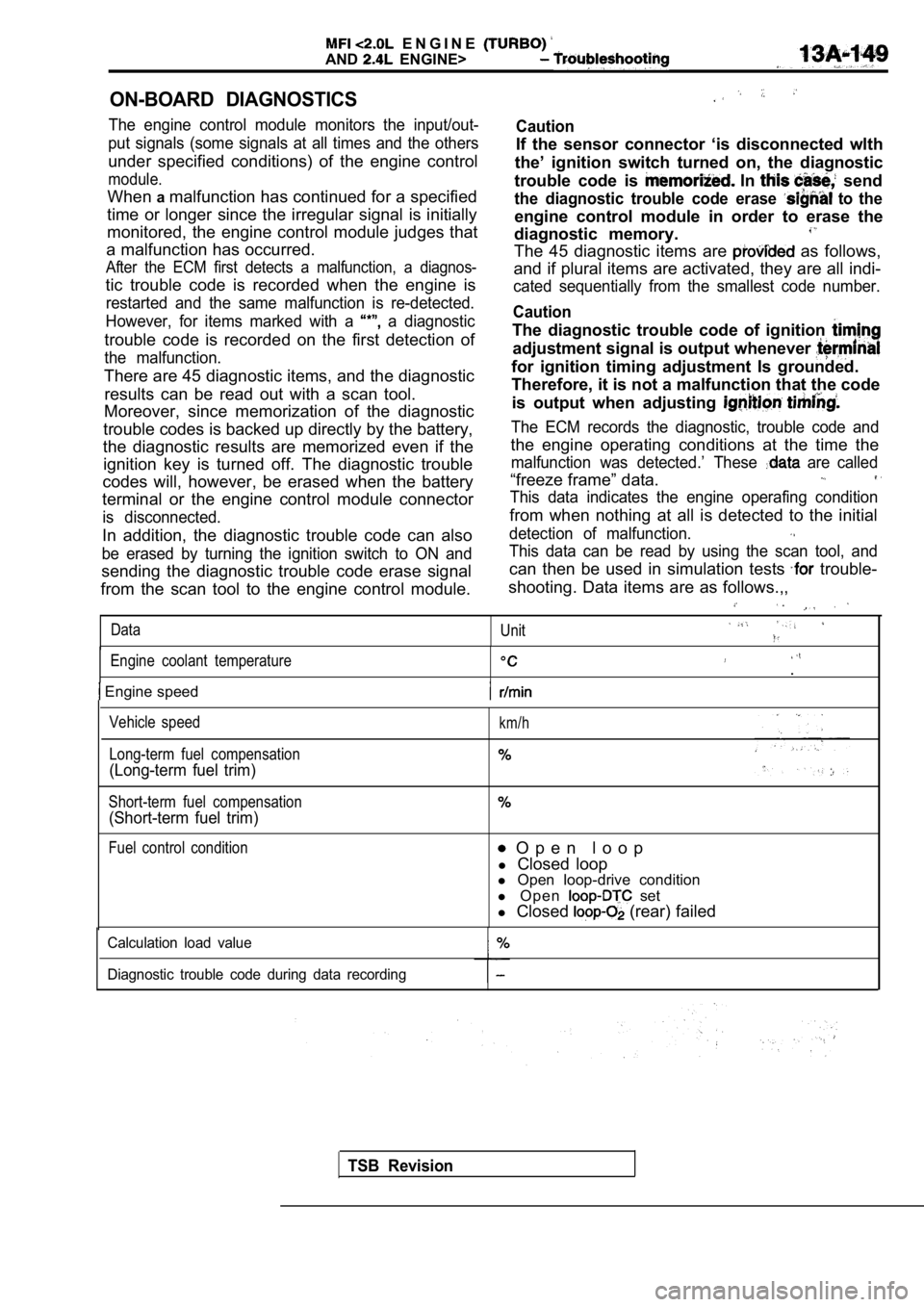
E N G I N E
AND ENGINE>
ON-BOARD DIAGNOSTICS
The engine control module monitors the input/out-
put signals (some signals at all times and the othe rs
under specified conditions) of the engine control
module.
Whenamalfunction has continued for a specified
time or longer since the irregular signal is initia lly
monitored, the engine control module judges that
a malfunction has occurred.
After the ECM first detects a malfunction, a diagno s-
tic trouble code is recorded when the engine is
restarted and the same malfunction is re-detected.
However, for items marked with a
a diagnostic
trouble code is recorded on the first detection of
the malfunction.
There are 45 diagnostic items, and the diagnostic results can be read out with a scan tool.
Moreover, since memorization of the diagnostic
trouble codes is backed up directly by the battery,
the diagnostic results are memorized even if the ignition key is turned off. The diagnostic trouble
codes will, however, be erased when the battery
terminal or the engine control module connector
is disconnected.
In addition, the diagnostic trouble code can also
be erased by turning the ignition switch to ON and
sending the diagnostic trouble code erase signal
from the scan tool to the engine control module.
Caution
If the sensor connector ‘is disconnected wlth
the’ ignition switch turned on, the diagnostic
trouble code is
In send
the diagnostic trouble code erase to the
engine control module in order to erase the
diagnostic memory.
The 45 diagnostic items are as follows,
and if plural items are activated, they are all ind i-
cated sequentially from the smallest code number.
Caution
The diagnostic trouble code of ignition
adjustment signal is output whenever
for ignition timing adjustment Is grounded.
Therefore, it is not a malfunction that the code
is output when adjusting
The ECM records the diagnostic, trouble code and
the engine operating conditions at the time the
malfunction was detected.’ These are called
“freeze frame” data.
This data indicates the engine operafing condition
from when nothing at all is detected to the initial
detection of malfunction.
This data can be read by using the scan tool, and
can then be used in simulation tests trouble-
shooting. Data items are as follows.,,
Data Unit
Engine coolant temperature.
Engine speed
Vehicle speed
Long-term fuel compensation
(Long-term fuel trim)
Short-term fuel compensation
(Short-term fuel trim)
km/h
Fuel control condition O p e n l o o p
l Closed loop
l Open loop-drive condition
l O p e n
set
l Closed
(rear) failed
Calculation load value
Diagnostic trouble code during data recording
TSB Revision
Page 531 of 2103
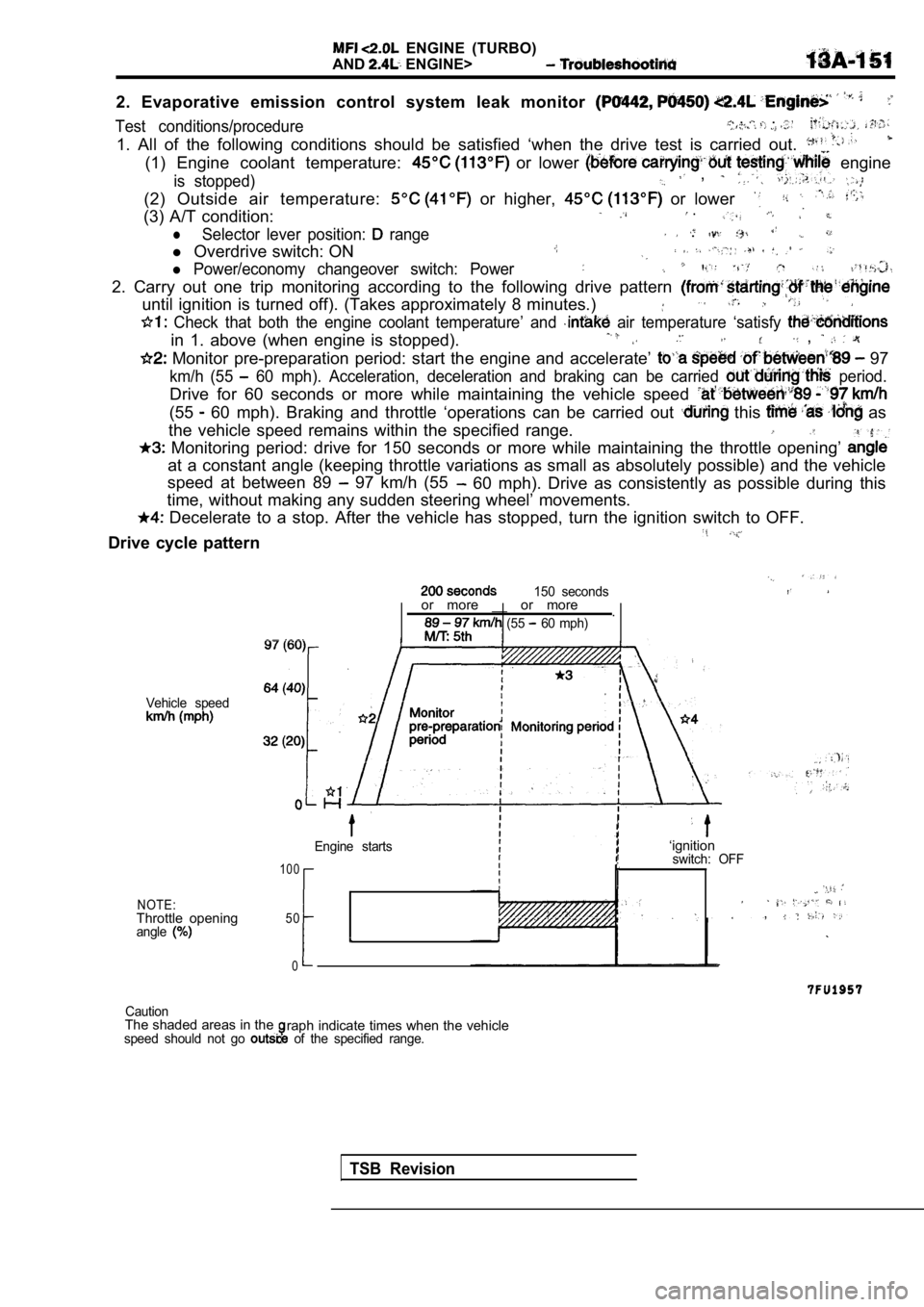
ENGINE (TURBO)
AND
ENGINE>
2. Evaporative emission control system leak monitor
Test conditions/procedure , . .
1. All of the following conditions should be satisfied ‘when the drive test is carried out.
(1) Engine coolant temperature: or lower engine
is stopped) ,
(2) Outside air temperature: or higher, or lower
(3) A/T condition: .
lSelector lever position: range .
l Overdrive switch: ON
l Power/economy changeover switch: Power
2. Carry out one trip monitoring according to the f ollowing drive pattern
until ignition is turned off). (Takes approximately 8 minutes.)
Check that both the engine coolant temperature’ an d air temperature ‘satisfy
in 1. above (when engine is stopped). ,
Monitor pre-preparation period: start the engine and accelerate’ 97
km/h (55 60 mph). Acceleration, deceleration and braking ca n be carried period.
Drive for 60 seconds or more while maintaining the vehicle speed
(55 60 mph). Braking and throttle ‘operations can be carried out this as
the vehicle speed remains within the specified rang e.
Monitoring period: drive for 150 seconds or more w hile maintaining the throttle opening’
at a constant angle (keeping throttle variations as small as absolutely possible) and the vehicle
speed at between 89
97 km/h (55 60 mph). Drive as consistently as possible during this
time, without making any sudden steering wheel’ mov ements.
Decelerate to a stop. After the vehicle has stopped, turn the ignition switch to OFF.
Drive cycle pattern
150 seconds
Vehicle speed
NOTE:Throttle openingangle
or more __ or more
.
(55 60 mph)
Engine starts
1 0 0
50
0
I
‘ignitionswitch: OFF
,
CautionThe shaded areas in theraph indicate times when the vehiclespeed should not go of the specified range.
TSB Revision
Page 532 of 2103
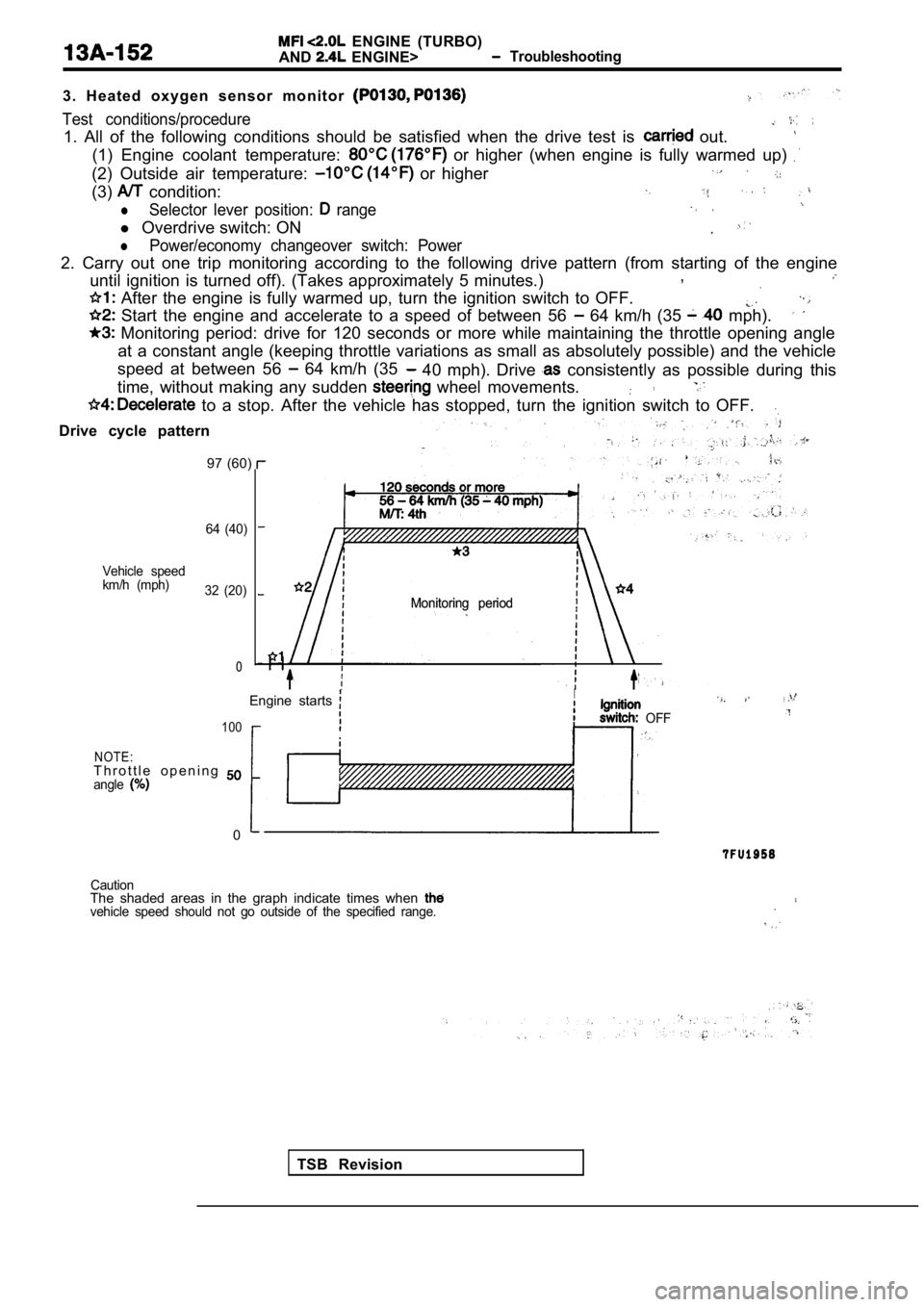
ENGINE (TURBO)
AND
ENGINE> Troubleshooting
3 . H e a t e d o x y g e n s e n s o r m o n i t o r
Test conditions/procedure
1. All of the following conditions should be satisf ied when the drive test is out.
(1) Engine coolant temperature: or higher (when engine is fully warmed up)
(2) Outside air temperature: or higher
(3) condition:
lSelector lever position: range
l Overdrive switch: ON.
lPower/economy changeover switch: Power
2. Carry out one trip monitoring according to the f ollowing drive pattern (from starting of the engine
until ignition is turned off). (Takes approximately 5 minutes.),
After the engine is fully warmed up, turn the igni
tion switch to OFF.
Start the engine and accelerate to a speed of betw een 56 64 km/h (35 mph).
Monitoring period: drive for 120 seconds or more w hile maintaining the throttle opening angle
at a constant angle (keeping throttle variations as small as absolutely possible) and the vehicle
speed at between 56
64 km/h (35 40 mph). Drive consistently as possible during this
time, without making any sudden
wheel movements.
to a stop. After the vehicle has stopped, turn the ignition switch to OFF.
Drive cycle pattern
97 (60)
64 (40)
Vehicle speed
km/h (mph) 32 (20)
0
Monitoring period
Monitoring period
TSB Revision
Engine starts
I. .
OFF100
NOTE:T h r o t t l e o p e n i n g angle
0
CautionThe shaded areas in the graph indicate times when vehicle speed should not go outside of the specifie
d range.
Page 533 of 2103
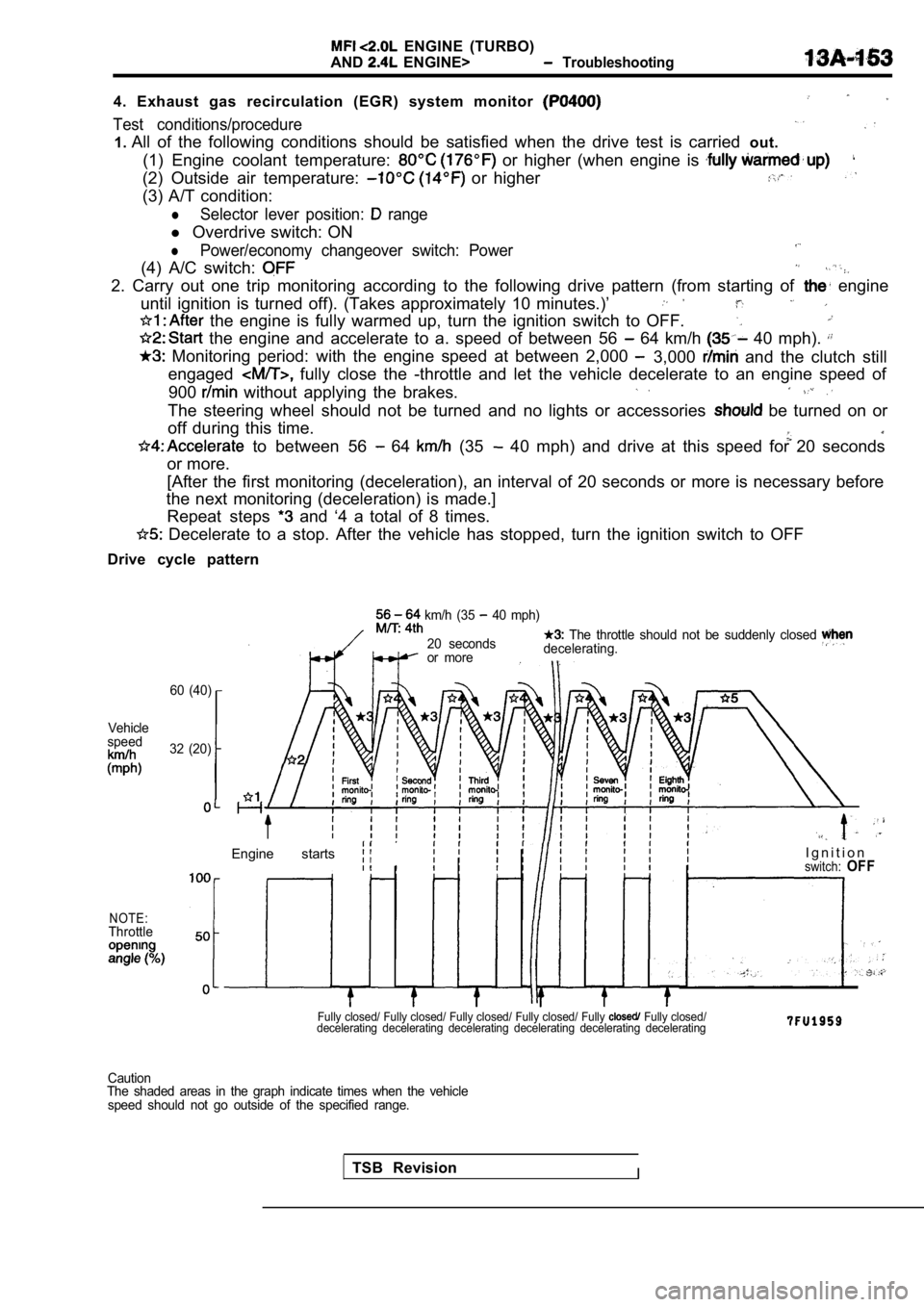
ENGINE (TURBO)
AND
ENGINE> Troubleshooting
4. Exhaust gas recirculation (EGR) system monitor
Test conditions/procedure
1. All of the following conditions should be satisfied when the drive test is carried out.
(1) Engine coolant temperature:
or higher (when engine is
(2) Outside air temperature: or higher
(3) A/T condition:
lSelector lever position: range
l Overdrive switch: ON
lPower/economy changeover switch: Power
(4) A/C switch:
2. Carry out one trip monitoring according to the f ollowing drive pattern (from starting of engine
until ignition is turned off). (Takes approximately 10 minutes.)’
the engine is fully warmed up, turn the ignition s witch to OFF.
the engine and accelerate to a. speed of between 5 6 64 km/h 40 mph).
Monitoring period: with the engine speed at between 2,000 3,000 and the clutch still
engaged
fully close the -throttle and let the vehicle dece lerate to an engine speed of
900
without applying the brakes.
The steering wheel should not be turned and no ligh ts or accessories be turned on or
off during this time.
to between 56 64 (35 40 mph) and drive at this speed for 20 seconds
or more.
[After the first monitoring (deceleration), an inte rval of 20 seconds or more is necessary before
the next monitoring (deceleration) is made.]
Repeat steps
and ‘4 a total of 8 times.
Decelerate to a stop. After the vehicle has stoppe d, turn the ignition switch to OFF
Drive cycle pattern
60 (40)
Vehicle
speed
32 (20)
NOTE:Throttle
km/h (35 40 mph)
20 seconds
The throttle should not be suddenly closed
or more decelerating.
Engine starts I g n i t i o nswitch:OFF
Fully closed/ Fully closed/ Fully closed/ Fully clo
sed/ Fully Fully closed/
decelerating decelerating decelerating decelerating decelerating decelerating
TSB RevisionI
Caution
The shaded areas in the graph indicate times when t he vehicle
speed should not go outside of the specified range.
Page 534 of 2103
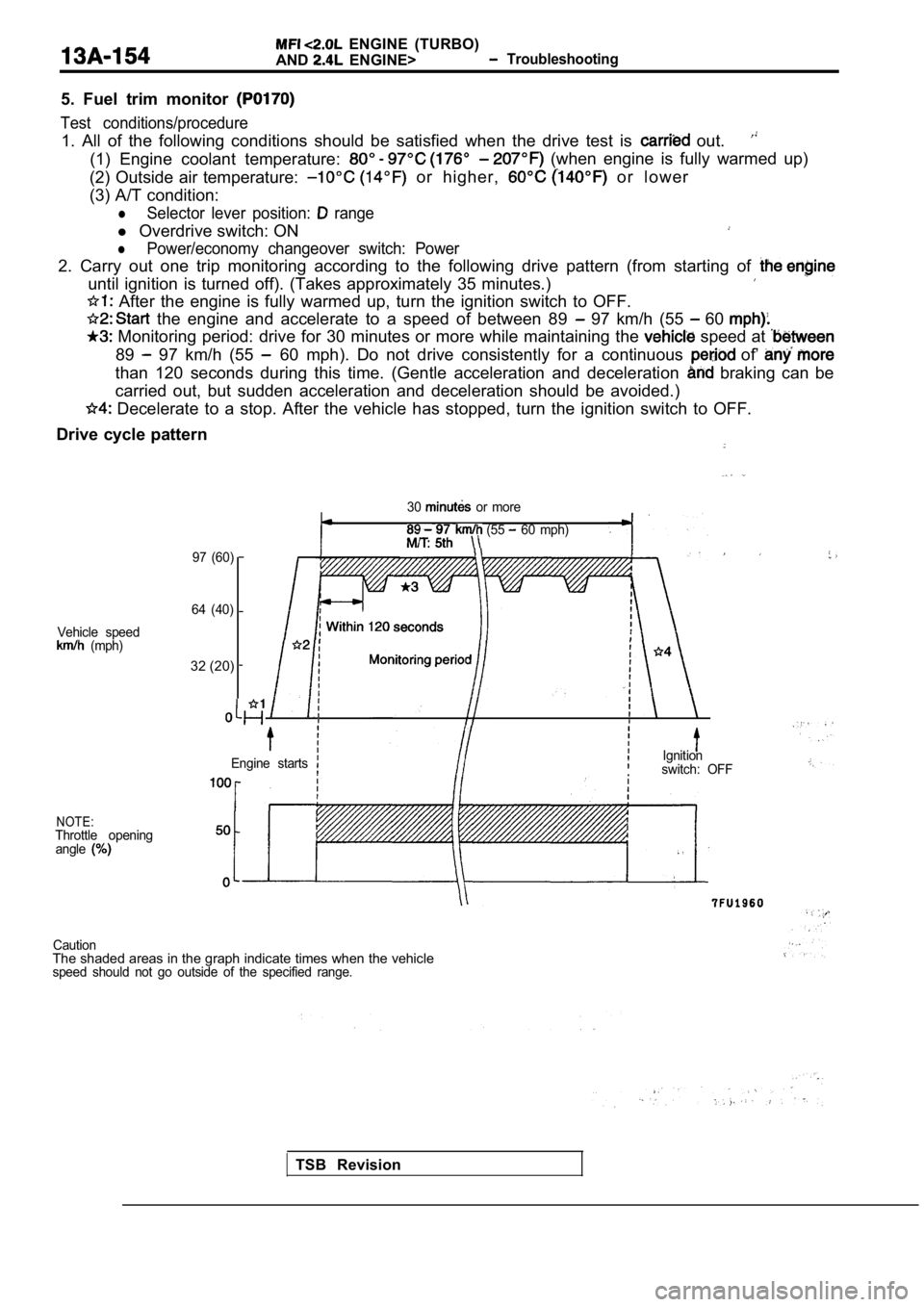
ENGINE (TURBO)
AND
ENGINE> Troubleshooting
5. Fuel trim monitor
Test conditions/procedure
1. All of the following conditions should be satisf ied when the drive test is out.
(1) Engine coolant temperature: (when engine is fully warmed up)
(2) Outside air temperature:
or higher, o r l o w e r
(3) A/T condition:
lSelector lever position: range
l Overdrive switch: ON
lPower/economy changeover switch: Power
2. Carry out one trip monitoring according to the f ollowing drive pattern (from starting of
until ignition is turned off). (Takes approximately 35 minutes.)
After the engine is fully warmed up, turn the igni tion switch to OFF.
the engine and accelerate to a speed of between 89 97 km/h (55 60
Monitoring period: drive for 30 minutes or more while maintaining the speed at
89 97 km/h (55 60 mph). Do not drive consistently for a continuous of’
than 120 seconds during this time. (Gentle acceleration and deceleration braking can be
carried out, but sudden acceleration and decelerati on should be avoided.)
Decelerate to a stop. After the vehicle has stopped, turn the ignition switch to OFF.
Drive cycle pattern
30 or more
(55 60 mph)
Vehicle speed
(mph)
NOTE:Throttle opening angle
97 (60)
64 (40)
32 (20)
Engine startsIgnitionswitch: OFF
CautionThe shaded areas in the graph indicate times when t he vehiclespeed should not go outside of the specified range.
TSB Revision
Page 535 of 2103
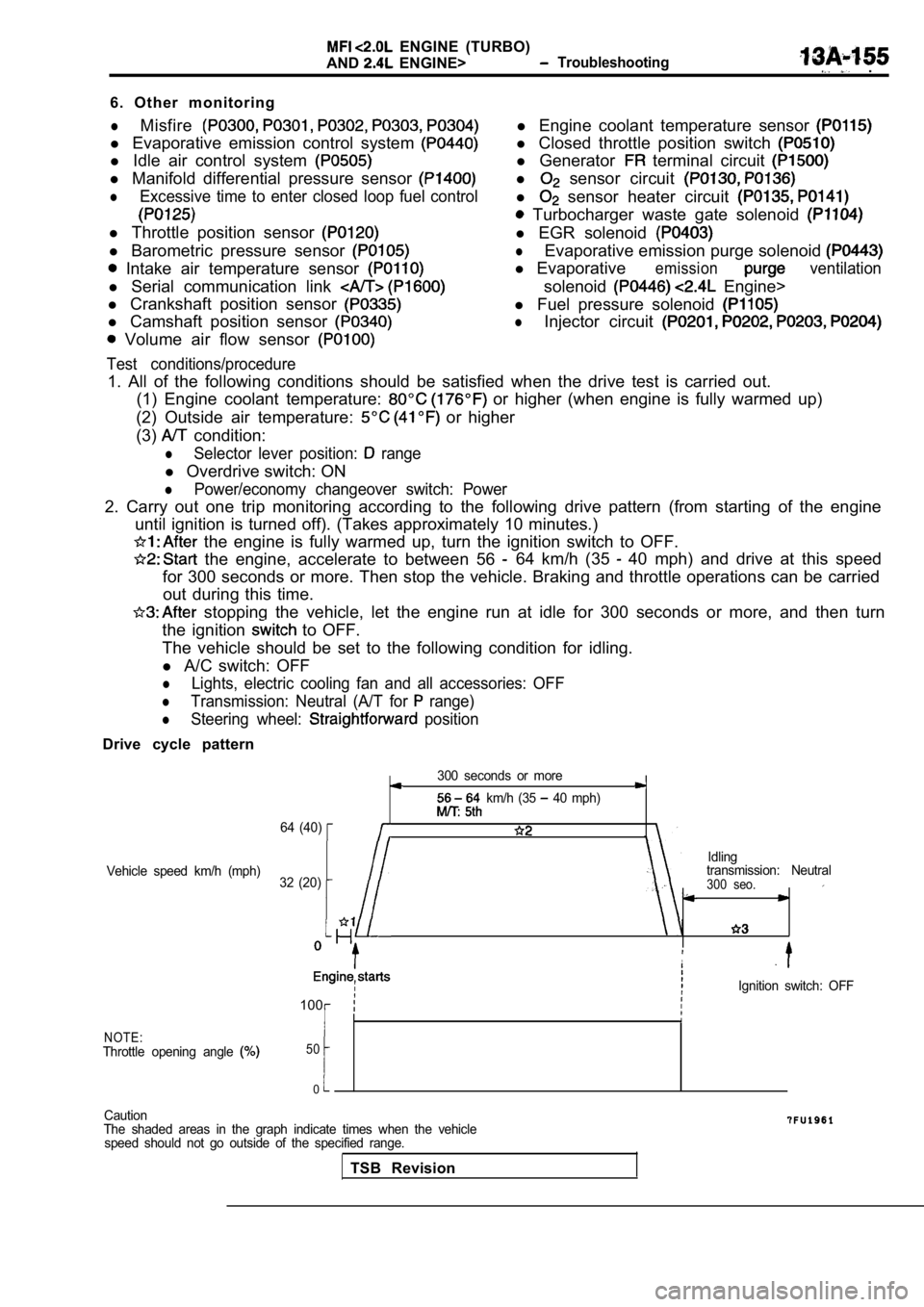
ENGINE (TURBO)
AND
ENGINE> Troubleshooting .
6. Other monitoring
lMisfire
l Evaporative emission control system
l Idle air control system
l Manifold differential pressure sensor
lExcessive time to enter closed loop fuel control
l Throttle position sensor
l Barometric pressure sensor
Intake air temperature sensor
l Serial communication link
l Crankshaft position sensor
l Camshaft position sensor
Volume air flow sensor
Test conditions/procedure
l Engine coolant temperature sensor
l Closed throttle position switch
l Generator terminal circuit
l sensor circuit
l sensor heater circuit
Turbocharger waste gate solenoid
l EGR solenoid
lEvaporative emission purge solenoid
l Evaporativeemissionventilation
solenoid Engine>
l Fuel pressure solenoid
lInjector circuit
1. All of the following conditions should be satisf ied when the drive test is carried out.
(1) Engine coolant temperature:
or higher (when engine is fully warmed up)
(2) Outside air temperature:
or higher
(3)
condition:
lSelector lever position: range
l Overdrive switch: ON
lPower/economy changeover switch: Power
2. Carry out one trip monitoring according to the f ollowing drive pattern (from starting of the engine
until ignition is turned off). (Takes approximately 10 minutes.)
the engine is fully warmed up, turn the ignition s witch to OFF.
the engine, accelerate to between 56 64 km/h (35 40 mph) and drive at this speed
for 300 seconds or more. Then stop the vehicle. Bra king and throttle operations can be carried
out during this time.
stopping the vehicle, let the engine run at idle f or 300 seconds or more, and then turn
the ignition
to OFF.
The vehicle should be set to the following conditio n for idling.
l A/C switch: OFF
lLights, electric cooling fan and all accessories: O FF
lTransmission: Neutral (A/T for range)
lSteering wheel: position
Drive cycle pattern
300 seconds or more
km/h (35 40 mph)
64 (40)
Idling
Vehicle speed km/h (mph) transmission: Neutral
32 (20)
300 seo.
,
Ignition switch: OFF
100
NOTE:Throttle opening angle 50
0
Caution
The shaded areas in the graph indicate times when t he vehicle
speed should not go outside of the specified range.
TSB Revision
Page 538 of 2103
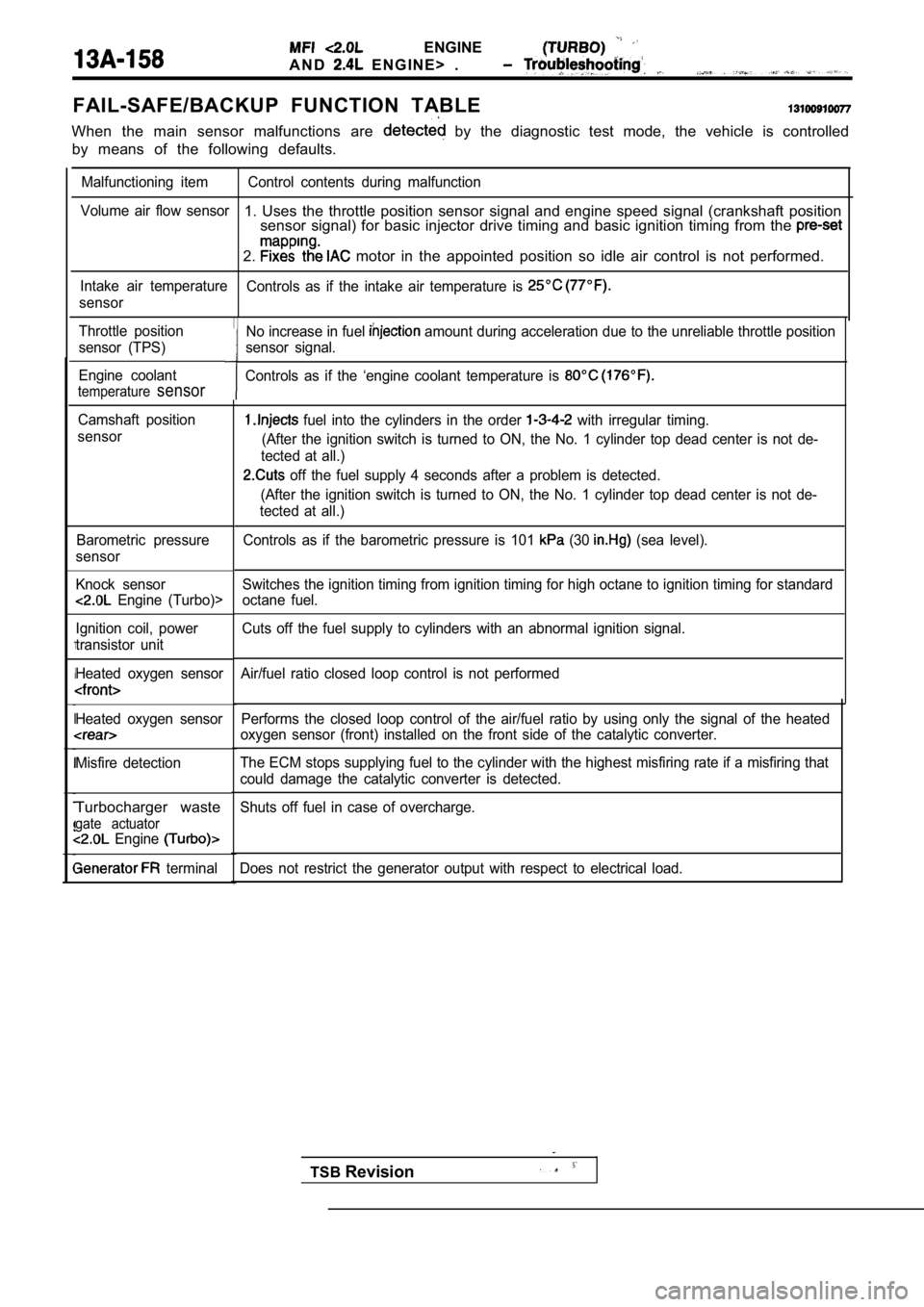
ENGINE
A N D E N G I N E > .
FAIL-SAFE/BACKUP FUNCTION TABLE
When the main sensor malfunctions are by the diagnostic test mode, the vehicle is controlled
by means of the following defaults.
Malfunctioning item Control contents during malfunct ion
Volume air flow sensor
1. Uses the throttle position sensor signal and eng ine speed signal (crankshaft position
sensor signal) for basic injector drive timing and basic ignition timing from the
2. motor in the appointed position so idle air contro l is not performed.
Intake air temperature
Controls as if the intake air temperature is
sensor
Throttle position
sensor (TPS)
Engine coolant
temperaturesensor
Camshaft position
sensor
Barometric pressure
sensor
Knock sensor
Engine (Turbo)>
Ignition coil, power
transistor unit
Heated oxygen sensor
Heated oxygen sensor
Misfire detection
Turbocharger waste
gate actuator Engine
terminal Performs the closed loop control of the air/fuel ra
tio by using only the signal of the heated
oxygen sensor (front) installed on the front side o f the catalytic converter.
The ECM stops supplying fuel to the cylinder with t he highest misfiring rate if a misfiring that
could damage the catalytic converter is detected.
Shuts off fuel in case of overcharge.
Does not restrict the generator output with respect to electrical load.
No increase in fuel amount during acceleration due to the unreliable throttle position
sensor signal.
Controls as if the ‘engine coolant temperature is
fuel into the cylinders in the order with irregular timing.
(After the ignition switch is turned to ON, the No. 1 cylinder top dead center is not de-
tected at all.)
off the fuel supply 4 seconds after a problem is d etected.
(After the ignition switch is turned to ON, the No. 1 cylinder top dead center is not de-
tected at all.)
Controls as if the barometric pressure is 101
(30 (sea level).
Switches the ignition timing from ignition timing f or high octane to ignition timing for standard
octane fuel.
Cuts off the fuel supply to cylinders with an abnor mal ignition signal.
Air/fuel ratio closed loop control is not performed
TSB Revision